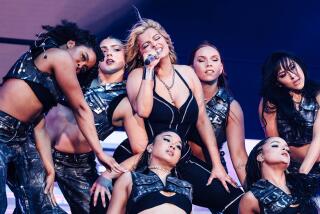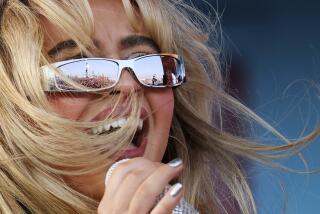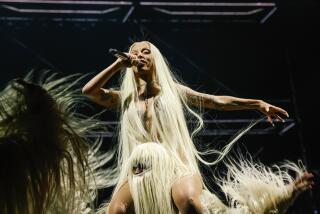Reporter’s Notebook: Electric Daisy Carnival proves EDM fests need fresh moves
As long as there has been electronic dance music, there has been at least one dumb complaint about it — that all the music sounds the same.
That’s a tedious line, one usually said by rock snobs who proudly admit they don’t listen to the stuff. But this year, they have a point — as least as far as dance music festivals go in Southern California and Las Vegas. The latter is the home of this weekend’s Electric Daisy Carnival, the main event for the L.A. promotion firm Insomniac.
Looking at this year’s sold-out EDC bill, it’s clear there has never been a better time to be a dance music fan in America, and Southern California in particular. But that embarrassment of riches has had a curious effect on the year’s marquee dance event.
PHOTOS: Concert photos by The Times
EDC’s comprehensive collection of 2013 dance music acts is oddly lacking in drop-everything-and-get-to-Vegas-now sets.
The problem isn’t that the top-tier artists headlining and supporting at this weekend’s Electric Daisy Carnival all sound similar to each other. They in fact represent a wide range: pop-friendly stadium titans such as Avicii and Tiesto, bleary minimalists such as Jamie Jones, dub step acts meant for crushing energy drink cans on your forehead.
The issue is that we’ve seen most of these acts recently — or are about to see them again very soon.
As headliners go, Tiesto headlined Staples in March, Avicii played Vanguard (now Create, another Insomniac-booked club) in February after a three-night Santa Monica stand in September, and Calvin Harris did the Hollywood Palladium in April. Dog Blood headlined Coachella’s dance tent this year, and will headline HARD Summer again in August.
The undercard? Arty, Madeon and Rebecca & Fiona played Insomniac’s own Exchange LA earlier this year; Eric Prydz, Jamie Jones and Richie Hawtin played major Coachella Valley Music and Arts Festival sets just a few months ago. Claude von Stroke and his great Dirtybird house crew have a whole tent at the upcoming HARD Summer; and Skrillex’s OWSLA label had their own with Alvin Risk and Dillon Francis at last year’s version of the same. Knife Party, Tommy Trash and Major Lazer topped the bill at HARD’s Day of the Dead last fall.
TIMELINE: Coachella and Stagecoach
There are a few left-field surprises, like Chicago house vet Green Velvet and synth-pop act La Roux — but not quite enough to make up for what’s all-too-familiar at this point.
One reason Electric Daisy is in this tough spot is that over the last few years, concert promoters have been in an electronic dance music arms race. New venues seem to open every few months; major firms like Live Nation are buying up stakes in indie promoters like HARD and Insomniac; EDM’s biggest acts are playing arenas like Staples Center, and L.A.’s downtown warehouse scene is just sopping with essential underground club nights.
This is more of a sign of a healthy L.A. night life ecosystem than any malaise in the genre or at Electric Daisy. But it does leave the fest with a weird task. What if being the biggest and the best fest of its scale isn’t synonymous with being exciting anymore? What if the saturation of EDM options in L.A. (and Vegas) has done the same thing to dance music that the Internet has done to pop culture in general: make everything too available all at once, all the time, to everyone?
At last year’s EDMBiz, a dance-music conference a few days before Electric Daisy, Insomniac founder Pasquale Rotella suggested that he’s losing interest in mega-bills of superstars, and wants to plow more of that money into the dizzying lights and installation art at Electric Daisy. Coachella took a similar tactic this year, dialing back on arena-fillers but revamping the Sahara Tent and introducing a new, incredibly popular Yuma tent for underground acts.
PHOTOS: Iconic rock guitars and their owners
EDC will need it, and maybe soon. Dance fests have a tougher time booking holy-cow sets than rock and generalist fests do (it’s hard to break up a band and reunite years later at Coachella when the “band” is just you behind turntables). The preponderance of venues and fests in L.A. means you’ll see potential new superstars come through town more often than your family, thus losing their novelty.
Electronic dance music won’t be at the vanguard of U.S. pop culture forever. The decisions promoters make now about how to present new stars in must-see ways will determine if the genre will be a perpetually relevant part of American night life, or a shorthand for that crazy Obama-era time when kids wore rimless sunglasses and neon bikinis to a racetrack rave in Las Vegas.
Now that we’re several years into an American EDM boom, it’s high time to ask the same questions that Europe did 20 years ago when it was facing the same issues. Any DJ worth his salt will have surprises at each new set. But if we’re going to treat DJs like rock stars, dance festivals have to deliver something singular and essential every time, if only to prove that this rich strain of music doesn’t all sound the same.
More to Read
The biggest entertainment stories
Get our big stories about Hollywood, film, television, music, arts, culture and more right in your inbox as soon as they publish.
You may occasionally receive promotional content from the Los Angeles Times.







